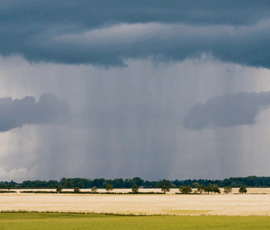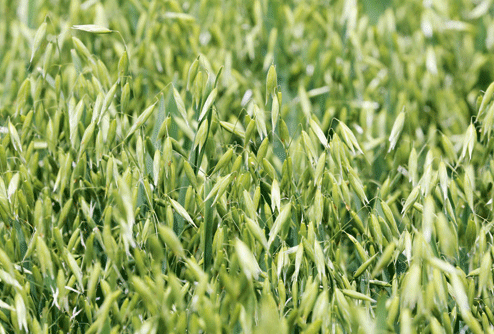Better data promises better mycotoxin assessments

More convenient and robust weather data to refine the HGCA’s mycotoxin risk-assessment tool could soon be available, giving growers a better insight into mycotoxin risks in their grain.
The HGCA risk-assessment tool was first developed in 2006 after Brussels introduced legal limits in grain. However, difficulties with obtaining accurate weather information have been a weakness, leaving question marks over the accuracy of the risk-assessment score, says Simon Edwards, of Harper Adams University College, who leads the development of the tool.
“Rainfall is a key factor in mycotoxin development, with the two high-risk periods for DON being during flowering and just before harvest. However, the risk assessment scoring system is based on crude measurements. We are trying to improve on that.”
Over the past three years, Prof Edwards has been leading work to develop more accurate and detailed weather data that growers can incorporate into the tool. Now HGCA funding worth £77,500 has just been obtained to enable the team, in partnership with Food and Environment Reasearch Agency, to undertake a two-year validation project.
“The aim is to be able to predict the key flowering and pre-harvest periods and obtain accurate weather information as close to an individual field basis as we can,” he explains. “Ideally we could then develop a web-based system where growers could input their location and obtain the relevant weather data.
“It’s not easy, especially as early June is particularly prone to erratic local weather events like thunderstorms. The information will never be perfect, but we think it will be a lot better than that being used in the current system. If all goes well we could be looking at a release just after the 2013 harvest.”
Other data including temperature and humidity, which influence fusarium development, may also be included, Prof Edwards adds.
“The more reliable we can make the data the more likely the industry is to use it. Preliminary results have already shown this will produce a better model and a more accurate risk assessment.”
Susannah Bolton, head of research and knowledge transfer at HGCA, says the improved rainfall data will help growers manage the mycotoxin risk in their grain even more effectively than before.
“Using more sophisticated measurements will improve its robustness. On our current analysis, the way the risk assessment is performing is giving us a pretty good picture of mycotoxin levels in the field. More reliable information can only improve that further.”
Hopes improved risk-assessments may cut pricey grain tests
Whether a revamped risk-assessment tool could replace expensive grain testing remains to be seen.
Many in the industry had hoped the tool would provide an accurate reflection of mycotoxin levels in grain, but it has never stood up to millers’ scrutiny in high-risk years.
This season is no different. Pre-movement testing remains millers’ first choice after 2012 was confirmed as a high-risk year for deoxynivalenol (DON) mycotoxin contamination following widespread fusarium head blight infection in many wheat crops, particularly F graminearum.
The findings were based on the industry’s intensive testing regime, carried out every year during the six weeks after harvest. A total of 8,000 samples were tested by millers and merchants. As a result, millers have insisted all grain destined for their intakes must continue to be tested from samples taken on farm.
If local circumstances indicate a low risk this may be relaxed, says Martin Savage, trade policy manager at the National Association of British and Irish Millers. But in many areas the position may not change for the rest of the marketing year. A risk assessment number will still be required with every load, but only to allow for testing the scheme’s accuracy.
Mr Savage hopes the inclusion of better weather information will improve the tool’s reliability. “We currently see a clear relationship between pre-movement testing and our rapid intake tests, but not between the risk assessment and the intake tests. The risk assessment tool is not robust enough in its present form – we need to iron out the problems and strengthen it.”
Millers have to prove to their customers they have taken proper steps to meet food safety legislation, and for now pre-movement testing remains a key part of that process, he adds. “All sellers have to prove that their food products are safe, and that includes farmers.
“This legislation adds a burden of cost to the whole supply chain, to millers as well as farmers. We hope that by refining the data and encouraging a better awareness of its importance on-farm the risk-assessment tool will come right.”
NFU chief combinable crops adviser Guy Gagen is less optimistic that the risk assessment tool will prove adequate enough for what he says is the millers’ increasingly cautious approach to mycotoxins.
Millers have retained on-farm testing nationwide this season even though Mr Gagen says their own data has identified the East Midlands as the only high-risk area.
“Most of the rest of the country is low risk with one or two pockets at medium risk, so not only are millers not accepting the risk assessment data, but also they are not accepting evidence from their own intake results.
“When it comes to mycotoxins we are one of the lowest risk countries in the world. Yes, there is legislation in place, but it includes many factors of safety. No one should pretend the authorities are going to get particularly heated about it, including the EU. There are a lot more important food safety issues about.”
Mr Savage disagrees. “Mycotoxins are taken very seriously and many major retailers examine carefully levels in finished products and say they are reassured by our approach to early-season testing.
“One reason for our start-of-season survey is that we try to identify where risk is low to save sellers the cost of testing, but in some years this is unavoidable.”

Tougher rules on oats kept at bay – for now
Tighter mycotoxin restrictions that were to be proposed by the European Commission and that threatened to cut 30% of UK oat production from milling markets have been headed off for now, says The NFU’s Guy Gagen.
Some member states have been pushing to introduce lower thresholds for T-2 and HT-2 mycotoxins in food and feed, despite assurances from the European Food Safety Authority that current thresholds adequately protected human health. However, following intense lobbying from trade and industry bodies representing affected parties the commission has dropped the proposals, says Mr Gagen. “We already have rigorous enough checks in place. And discouraging people from eating a healthy food like oats was never a sensible idea.”
In a further development, an advanced legal framework is under discussion to speed up the granting of certain derogations for zearalenone (ZON) mycotoxin levels in difficult years.
ZON is mainly found on bran. In wet harvest years the threshold of just 100ppb can have a big effect on millers and potentially on growers supplying them, says Mr Gagen.
“There are no real human health issues involved with occasional derogations. But over-threshold ZON levels put enormous pressure on this part of the supply chain. We are trying to make sure that these vulnerable areas are not affected unnecessarily.
Keep up with the latest arable news

